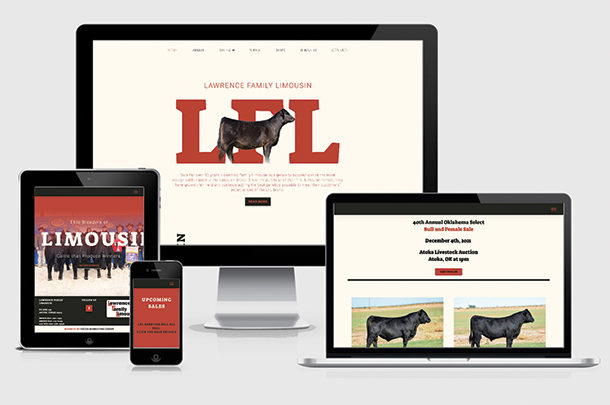“Where do we start?” A common question that runs through most folks’ minds when they decide their operation is ready for a website. Websites can be intimidating but, with a little planning and guidance, a website can be the most pivotal marketing tool a cattle operation can utilize.
In today’s world, if you have a business, there is substantial pressure to be “online” in one way or another … whether this is on social media or through your own website. While these are powerful tools, they require careful consideration, attention to detail and proper maintenance to truly reach their full potential.
Once you’ve made the decision to start your website, there are a few things we feel you should prioritize in order to make the process as streamlined as possible and create the best results:
Surf the web
- Spend time online looking at other operations’ websites.
- Determine your likes and dislikes.
- Ask yourself how detailed or simple you want your website to be.
Plan and prepare
- Gather the information you would like displayed or linked on your website.
- Locate the photos you would like to feature and save in one location which you can easily access or share with a professional.
- Determine the domain name you would like to use (your website’s “www.” address) and if it is available.
If the domain name you have your heart set on is not available, there are many alternatives, like choosing “.net” versus “.com.”
Ultimately, the basics of a good website come down to content and how information is organized. This is where hiring a professional is helpful. However, website designers can only work with the information and content provided. You may determine new photos need to be taken, you would like a new logo created, or cattle registration information needs to be tracked down so your website is everything you envision it to be.
Aside from the design of your website, utilizing professional website services have many benefits the average individual may not consider. Technology is an amazing thing but, as we all know, there are some days where technology is not our friend.
In the last 10 years, technology has become more prevalent in our everyday lives. Most of us walk around with a small computer disguised as a phone in our hands. Because of this, websites not only need to look good and function on large computer screens but on small phone screens as well.
According to Statista.com, over half of all web traffic worldwide is generated from a mobile device. This is especially true for farmers and ranchers, who are famous for doing business at all hours of the day from mobile offices in a tractor or pickup truck.
When working with a professional to create a website, they take the time to ensure your website simply works, which in itself is not all that simple. Websites need to have proper security, coding and management to make sure they stay up and running correctly. A website designer will also add in key words in the back end of a site, to allow for optimum search engine optimization (SEO). Ensuring your website works as it should and keeping it up to date is just as important as the design.
Without SEO, many websites would go unvisited. By having this optimization, this guarantees your website can be easily found across all search engines. This is an item which web developers can easily enable on the back end of building a website, whereas with some pre-made template sites, this is more difficult. SEO, spam protection and troubleshooting are all items a web developer takes time to understand and implement in their websites.
If you choose to work with a web professional to build a website, the process does take time. It all starts with a conversation to review your wants and needs as well as a list of everything that must be on the site.
The basic process
- Website designers will create a mock design of your home page and determine any changes or additions to the initial concept.
- Determine the number of pages you would like to feature on your website, for example: Home, About, Bulls, Females, For Sale and Contact.
- Setup: The designer will take care of all of the back end, like establishing your domain name, ensuring your site is secure from hackers and malware, and optimized for web browser searches.
- Share content with the designer in a secure and organized way. We recommend using an application such as Dropbox.
- Home page will be created and proofed by all parties.
- Remaining pages are then designed.
- Review the completed site and make final edits.
- Add SEO keywords to the back end of the site.
- Launch.
- Promote across social media/print ads.
Easy, right? While building a website can be intimidating, working with a professional can relieve stress and actually make the process quite fun. You are left with a high-quality, mobile-friendly website which can take your operation to the next level. However, the journey doesn’t stop there. Websites need to be maintained, visited regularly and kept up-to-date with current information.
Website updates
Once you have launched your website, there are many changes you may foreseeably need to make in the future. These can be as simple as name or address changes, contact information, updating pictures or deleting a sire which you have sold. It is important to stay on top of these changes as they need to be made.
Websites that are updated regularly will receive better rating on search engines, thus listing them higher in search results.
A common feature we see on most cattle websites is a For Sale page. Cattle producers utilize these pages to showcase private treaty cattle or to advertise upcoming sales. When it comes to updating your website with information for an upcoming sale, organization is most important.
Here are some tips to simplify the process:
- Save all sale photos with the lot or registration number as the file name.
- Send a corresponding document with lot numbers, registration numbers, pedigree information and any additional write-up you would like to include.
- If utilizing a sale catalog, provide a digital copy to be displayed or linked to the website.
- If using an online platform for your sale, provide the sale site link.
Sale updates are very timely, and organization is key to ensure this information is displayed correctly on your website. As soon as you set a sale date and begin your advertising, be sure to share that information with your website manager. All livestock professionals have the same busy season, so it is important to send sale updates far enough in advance of your sale to guarantee they will be seen by potential buyers.
Whether you are in the very early stages of determining if your operation is ready for a website, or perhaps you have one which needs attention, it is important to not become discouraged. There are few individuals who can run a successful cattle operation while also maintaining their own website. While websites can technically be done in-house at your farm or ranch, and there are plenty of do-it-yourself website creators available, it’s a challenge to do it all and do it well. Working with a website professional can help streamline the process and let you focus on everything else it takes to manage a cattle operation.










